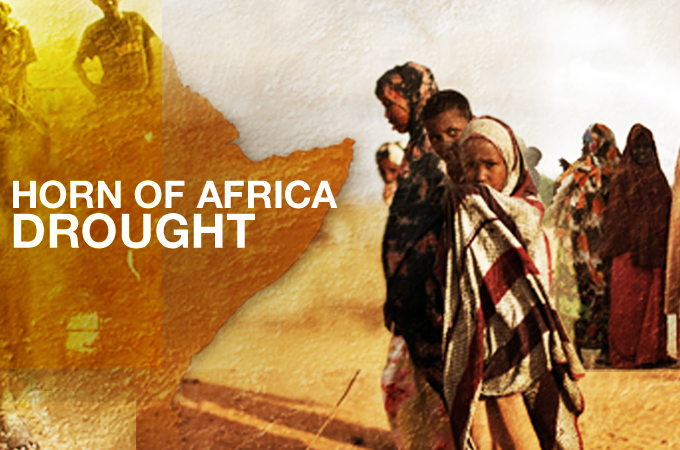Horn of Africa: A devastating drought
The world has watched in horror as the humanitarian disaster continues to ravage 13 million people, making it our No. 4.

 |
| The rampant death, starvation and displacement has been exacerbated by the political mess in Somalia [EPA] |
Death, starvation and displacement cried some parts of Africa seeking the world’s attention and relief, as some 13 million people in the Horn of Africa, including Somalia, Ethiopia and Northern Kenya as well as pockets of Uganda, Djibouti and Sudan, were affected by a drought described as the worst in 60 years.
As entire regions dried up, the world watched in horror as tens of thousands of farmers, mostly pastoralists, lost their lives, and hundreds of thousands were forced to flee homes for survival, in search of food and shelter.
Keep reading
list of 4 itemsUS sanctions two RSF commanders as fighting escalates in Sudan’s Darfur
Israel’s war on Gaza updates: 600k displaced from Gaza since May 6 – UN
Did the UN really say Israel has killed fewer people in Gaza?
By mid-2011, between 800-1,000 refugees from Somalia were arriving at the Dadaab Refugee Camp in Kenya or Dolo Ado in Ethiopia, on a daily basis, setting off alarm bells that the Horn of Africa needed desperate and immediate international attention, despite early warning systems (Six months earlier, FEWS, had warned of incessant food shortages in the region). The situation had worsened drastically by the time international media descended on Dadaab to tell the stories of women – who had left their husbands behind to mind over cattle or protect property – walking hundreds of kilometres from Somalia, which had often resulted in the deaths of their malnourished offsprings; and the UN calculated that $2bn was required to avert a complete humanitarian disaster.
 |
| View Al Jazeera’s special coverage of the famine |
It is estimated that 250 children died every day from malnourishment, while the death rate reached between 5 and 7 per 10,000 per day in parts of Somalia, forcing the UN to declare famine in parts of Somalia: the first such declaration in three decades.
As the repercussions of food shortages took grip of the region, and questions began to be asked over culpability over the existence of famine in the 21st century, the humanitarian disaster soon became an agonising reminder that the humanitarian disaster was a symptom of a larger story involving a two-decade-long civil war that has devastated the very social fabric of Somalia.
As it stands, Somalia remains without an effective central government or health sector and has little infrastructure to manage the series of environmental shocks, including drought and desertification and climate change, that has severely affected the country and its inhabitants over the past decade.
Moreover, the continued insecurity in Somalia made conditions for international relief agencies to operate incredibly difficult in a complex environment where food aid has been effectively used as a political tool, as militia groups and Transitional Federal Government (TFG) forces continue to struggle for supremacy in the country.
Nothing more expressed the complexity of this situation than documenting the story of refugees who had left Somalia in 1991 when the country descended into civil war, only to find themselves at the camp even after 20 years, now helping document new refugees. By December 2011, more than 152,000 refugees had arrived in Dadaab during the course of the year, taking the total population to 444,000 in a camp originally designed to cater for 90,000.
International media attention might have now shifted from the drought, but two zones are still famine declared areas as the drought continues in parts of southern and central Somalia.
The advent of Kenyan troops moving into Somalia, later followed by Ethiopian forces, following a spate of kidnappings and attacks inside Kenya, allegedly by militia group, al-Shabab, has added a new spin to the story.
The drought continues, but impatience grows over the lack of progress in resolving Somalia’s civil war. All eyes will be on Somalia in the New Year, as the TFG mandate approaches an end, the country hopes to hold national elections in 2012.